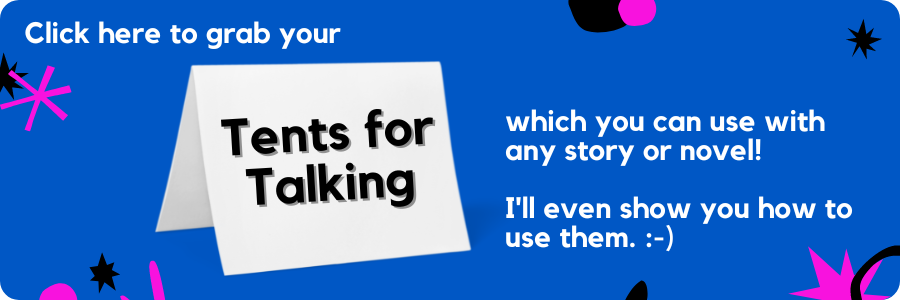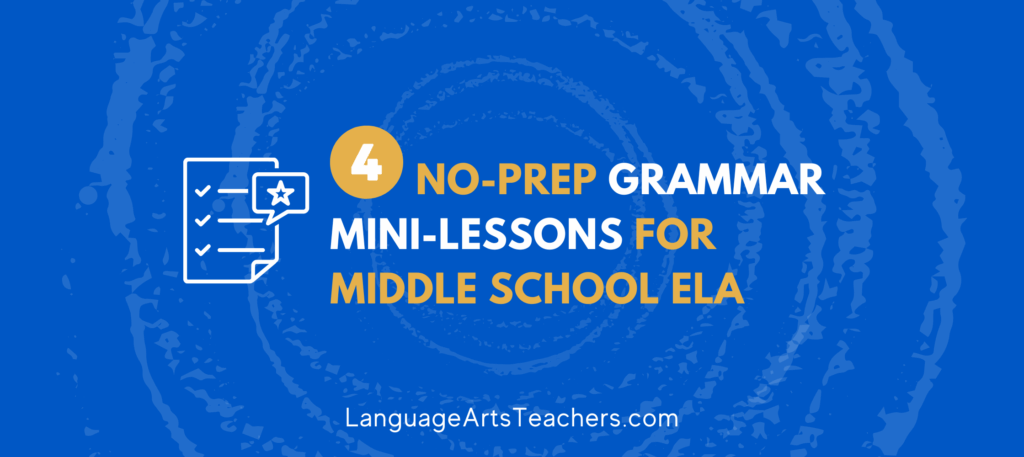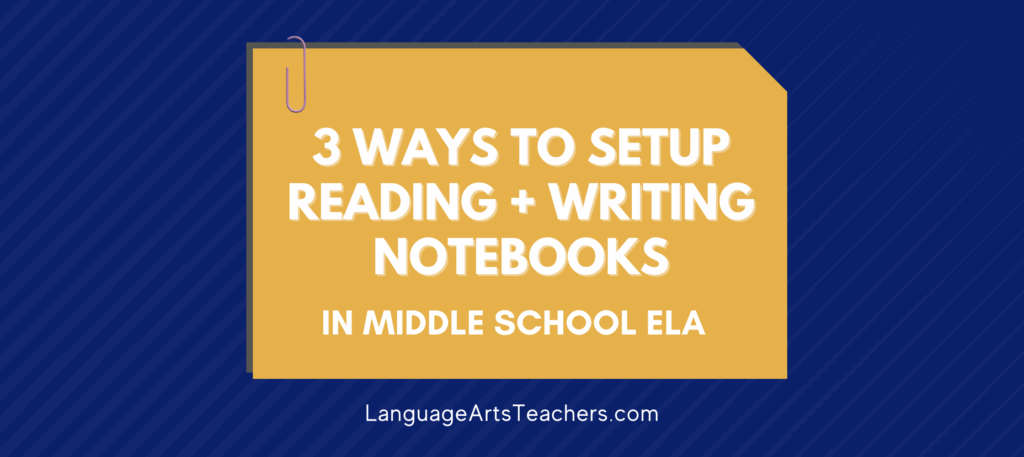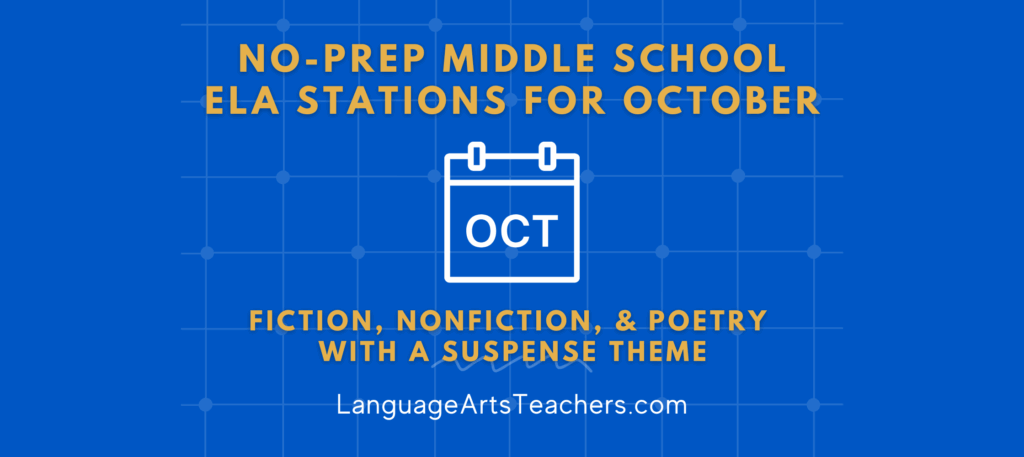If you’re a new 6th, 7th, or 8th Grade ELA Teacher looking to plan and organize a fiction unit, you’re in exactly the right place! Let’s take a look at the basic elements of a fiction or short story unit so you feel confident in what to teach when you’re first getting started.
This will allow you to provide your students with a better understanding of how a good story should be laid out. It’ll also provide you with a set of elements that you can talk about with your students all year long, applying them to different stories.
First, we’ll go over the most common, fundamental terms for fiction that you’ll need to use and discuss with your students. Then, we’ll break down what to do in a week and how to lay out a short story lesson in your fiction unit.
Standards / Skills Overview (6th, 7th, 8th grade)
When it comes to covering fictional short stories, there are a number of different areas that you can focus on. But if you really want to dive deep and help your students have a better understanding of everything that goes into a great story, it helps to have a basic outline of some of the different areas that you should be focusing on.
So here are some academic terms and breakdowns of these terms that you can highlight with your students (this list won’t cover them all, but it’ll give you a good starting point).
Characterization – When it comes to characterization, there are a few key elements to consider. First of all, what does the character look like? What are their physical features, and how do they dress? Noticing these details and talking about them will give readers a good sense of the character’s personality and lifestyle.
Secondly, how does the character speak? Do they use formal language or slang? Are they eloquent or more straightforward? This can help to give readers an idea of the character’s environment, atmosphere, time period, or location.
Finally, what do other characters think about the character in question? This can be a useful way of getting an outsider’s perspective on the character and their motivations.
Ultimately, by considering all of these factors, student readers can gain a well-rounded sense of who the character is and what makes them tick.
Plot Development – When creating a story, plot development is key. The setting, location, and time period chosen will have a big impact on the events that take place and the characters that populate the story. A story set in a small town in the 1950s will have a very different feel than one set in a big city in the present day.
The same is true of a story taking place on a ship at sea or in a remote cabin in the woods. The choices made by the author regarding setting, location, and time period will help to shape the story and create an immersive experience for readers.
One of my favorite questions to engage my students is to ask them how a particular story’s plot would change if it were set 100 years in the future, or 50 years in the past. Play with what would happen (or not happen) if certain elements of the story were different. Would certain challenges cease to exist, or what new challenges would present themselves that could alter the plotline?
Inciting Incident – All great stories have one thing in common: an inciting incident. This is the event that sets the story in motion, changing the course of the protagonist’s life and setting off a chain of events that will ultimately lead to the story’s resolution. Without an inciting incident, there would be no story to tell.
The inciting incident is often the result of chance or circumstance, but it can also be the result of a decision made by the protagonist. Regardless of its cause, the inciting incident must be sufficiently compelling to persuade the protagonist to take action and embark on a journey that creates a page-turning story.
In some cases, the inciting incident may not be apparent until well into the story, but it is always there, lurking in the background, waiting to make its presence known.
So what exactly is an inciting incident? It is simply that one event that changes everything. It’s the first challenge, problem, or decision that sets the story in motion and that keeps the reader engaged.
Rising Action – The rising action is the part of the story where the main character encounters various conflicts that will ultimately lead to the climax. This is often when the stakes are raised, and the tension begins to build.
For example, in a mystery novel, the rising action might be when the detective starts to put together the clues and realize that someone is trying to frame them for murder. In a romance, the rising action might be when the two protagonists start to fall in love but are keeping it a secret from each other because they don’t believe the feeling is mutual.
Whatever form it takes, the rising action is an essential part of any story.
Turning Point – The turning point in any story is the point at which the protagonist must make a decision that will change the course of the story. This decision may be something as small as choosing which path to take, or it may be a life-changing event. Either way, the turning point is always a critical moment in the story because at this point, there is no going back. The character must live with the consequences of their decision. This can be a very tense moment for readers as they wonder what will happen next, and can’t put down the book or can’t stop reading because surely there’s no way the character can make it out of the situation! It’s a very exciting moment as it sets up the rest of the story and determines whether the character will succeed or fail.
No matter what happens, the turning point is always a pivotal moment in any story.
Falling Action – The falling action is a series of events that follows the turning point and leads to the end of the story. This is usually where the characters start to tie up loose ends, resolve conflicts, and deal with the aftermath of the turning point.
The falling action can be a tense and exciting time, full of twists and turns, as the characters race toward the end. If your students are really hooked on a story you’re reading in class, then take this as an opportunity to talk about the falling action in terms of what is happening, why it’s happening, and how the characters’ decisions are pushing the plot forward to the conclusion.
Resolution – The resolution, or conclusion, is the final part of the story when all the loose ends are tied up, and the reader learns what happened to the characters. It is often seen as the most important part of the story, as it can make or break the reader’s experience. A good resolution should be satisfying, providing closure for the reader while also leaving them with something to think about. Students typically love the ending or hate it altogether! It’s a good time to talk about clues and foreshadowing from throughout the book that possibly hinted at how the ending came to be. Or, you can talk about the ripple effect that characters’ decisions had on the development of the plot all throughout the story.
The resolution should also be consistent with the rest of the story, wrapping up plot threads in a believable way. Done well, a resolution can leave the reader feeling satisfied and engaged, eager to recommend the story to others. Done poorly, however, and the reader may feel cheated or even angry, vowing never to read anything by that author again. Allow students to share what made the resolution a great one, or a poor one. You’re helping them learn what elements make for a fantastic story, and how to talk about them in a productive way that enhances their comprehension.
As such, it is clear that getting the resolution right is essential for any author who wants to create a successful story.
Get all the strategies and plans you need for Middle School ELA from the 5-day virtual conference I hosted specifically for 6th, 7th, and 8th Grade Reading & Writing Teachers! It’s the MSELA Summit, and it has 30 hours of on-demand sessions (and PD Certificates!) for you about unit planning, tech tools, classroom management, reading and writing strategies, and more that you can use all year long.
Organization of the Unit
Broadly teaching a story without any depth can result in many students not fully understanding the material. But when you teach one story deeply, you can help to ensure that all of your students are on the same level and comprehending the information.
By taking the time to pick one story and analyze it deeply, you will be able to teach all the elements of a story. This includes characterization, plot development, inciting incident, rising action, turning point, falling action, and resolution.
By ensuring that your students understand each element fully, they will be able to apply this knowledge to any story they read in the future. Consequently, teaching deeply is more beneficial than teaching broadly because it allows for a complete understanding of the material that can then be applied to other stories or even novels students will encounter in class.
Breaking down a story during the week.
Monday: Read through the whole story and talk about the basic points of the story. You can do this by reading aloud or going on YouTube and finding an oral reading of the story. Or you can record your voice reading the story if you are going to use it multiple times for multiple classes.
This is usually more effective than having students read it on their own, as reading levels will vary in your classroom, and some kids may not be able to grasp the story or even finish it while others will finish very quickly.
Tuesday: Read only the portion that you want to discuss. Maybe start with the plot and go into the details of all that is happening with developing the plot of the story.
Wednesday: Focus on character motivation and read just the portion of the story that hits on a specific type of conflict, dialogue, etc.
Thursday/Friday: If you have already gone over all of the basics of the story, you can dive into foreshadowing, what the author was thinking, flashback, symbolism, etc.
For ideas about what “talking about the story” can actually entail, check out my wildly popular “Tents for Talking” that puts the discussion on the students while freeing you and them from meaningless, tedious story worksheets.

Everything that your students will learn here will help them later on when it comes to longer novels that they are required to read. This type of breakdown and the elements of fiction will allow your students to better follow along when reading later on.
How to begin the unit
YouTube has a plethora of videos to support the teaching of themes/units in ELA. A quick search for “Pixar movies” or “read-aloud books” will result in some excellent options. These videos provide an engaging and entertaining way to incorporate read-alouds of popular short stories that you can use throughout your fiction / short story unit.
In addition, they provide a low barrier of access so that all students can view, discuss, and participate in academics around elements of fiction. They’ll build confidence in themselves and can then apply the learning to what they’ll later read. After watching one or more of these videos, you can then begin delving into the specific short story or texts that they do need to read. This approach provides a well-rounded and engaging way to begin your unit that supports struggling students while also engaging all your students.
How to End the Unit + Assessments + What to Teach Next
Having students write in the same genre they are reading is an amazing experience! After you have experienced a few different fictional stories, take some time (a week, if possible) to have students write their own story in a first-person point-of-view where they are the main character. For the sake of a simple example, let’s put each student on an island as the setting. This is one I love to do with my own classes of middle school students! They’re each on their own island, totally alone! What kind of island is up to them. It could be a tropical island of course, but you may have students choose an “outer space” island, or a glacial island, or an island in the middle of a lake. Give them a chance to use their imaginations and be creative here!
On the first day of writing, have them describe their location and setting. Let the students explore what the island looks like and what kind of emotions they are feeling being stranded. Challenge them to write specifically about what they see, smell, taste, hear, and feel. An even deeper challenge is to describe where they are without ever using the word “island.”
On the second day, you can get into characterization and an inciting incident. Are there other people on the island? Is there a situation that comes up? The student should start to think about how their character would react to these events.
On the third day of writing, what decisions have to be made based on problems, mysteries, or other events that they encounter on the island? It’s all about helping your students think about the elements of a short story, and how they are able to address those elements in their own writing experience.
And then on the last day, focus on the resolution of the story. Did the main character have a revelation? What did they learn from their time on the island? The student can reflect on what they have written and how their character has changed over the course of the story.
All of this will allow students to implement what they have been learning throughout the weeks they’ve spent experiencing the elements of fiction. The goal here isn’t that they write a stunning best-selling short story. The goal is that they not only can recognize the basic elements of fiction, but that they understand how those elements work together while getting some writing practice along the way.
Grading and Assessing: The story does not have to go through a complicated revision process if you don’t want to or don’t have time to do so. It’s ok for stories to remain in an unfinished draft mode. The experience is what counts here. You may decide to assign a grade for completion of the main elements of fiction in the story, or you may choose not to assign a grade at all. It’s up to you. If you’re curious, I like to assign a grade for completion. Then, when I teach elements of grammar, mechanics, or sentence structure, I like to have students implement what I just taught them by applying the lesson to their own writing (rather than a random worksheet I pulled from somewhere). I have my students keep their unfinished drafts all throughout the year, building up a library of their own writing that they then return to for the purpose of practicing grammar, mechanics, sentence structure, etc.
Fiction Unit Planning Conclusion
The biggest takeaway I hope you have here when it comes to your fiction / short story unit is that it comes down to quality over quantity. If you feel pushed to cover a bunch of different stories but don’t have time to teach your students the basic elements of fiction, they will potentially struggle later on.
As a teacher, you will have more enjoyment diving deeper into a story rather than just going over the basics each time and then moving on. For struggling readers, spending more time on a short story and going into more depth helps them access the story and build confidence in their own learning. If they’re constantly having to start a new story every day, for instance, then it’s always a struggle to comprehend vs. having time or energy to devote to plot analysis.
Get all the strategies and plans you need for Middle School ELA from the 5-day virtual conference I host specifically for 6th, 7th, and 8th Grade Reading & Writing Teachers! It’s the MSELA Summit, and it has 30 hours of on-demand sessions (and PD Certificates!) for you about unit planning, tech tools, classroom management, reading and writing strategies, and more that you can use all year long.




